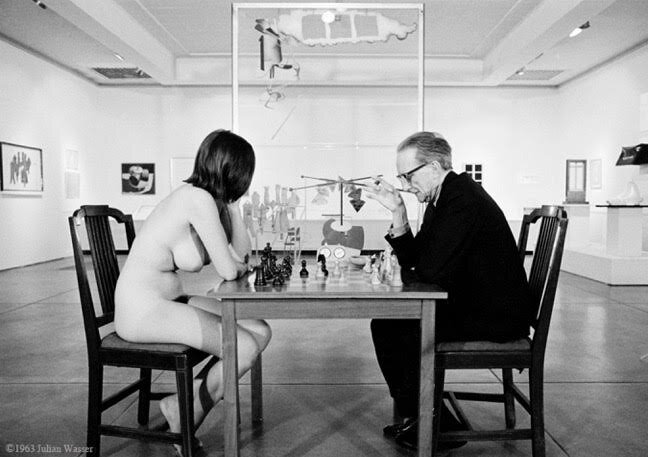Eve Babitz Chess Photo with Marcel Duchamp
In 1963, at the Pasadena Museum of Art, a chess match took place between a naked woman and a clothed man. This woman, Eve Babitz, was only 20 years old and would later become an icon of Californian culture. The man was Marcel Duchamp, a renowned artist and chess professional. The iconic and unusual photo of the chess game became one of the most famous of all time, with Babitz’s daring nude as its central focus. However, it is important to understand the meaning of this image by looking more closely at the two individuals and their respective backgrounds.

Marcel Duchamp was born in France in 1887 into a family of artists. His exposure to Cubist art, literature and the technical developments of his time influenced his artistic work, which included “ready-mades” (Objet trouvé), where everyday objects were transformed into works of art. Duchamp was known for this type of art, the most famous being the “Fountain”, an upside-down urinal. In the 1920s, Duchamp turned his attention to chess and almost stopped his artistic work to become a professional chess player. He played in five Chess Olympiads for the French national team and even published a book on chess.
Eve Babitz was born in Hollywood in 1943, the daughter of an artist couple. She partied in California bohemian circles and met many celebrities like Jim Morrison, Steve Martin and Harrison Ford. Babitz later published several books about his youth in California, as well as producing several works of art.
The Eve Babitz chess photo was taken at the Pasadena Museum of Art during a party celebrating a Duchamp exhibition. Among those in attendance were a number of other fashionable Californian artists, including Man Ray, pop-art artist Edward Ruscha and Andy Warhol. Babitz’s presence was unexpected, as the museum director had not invited her. Despite this, she ended up immortalizing the date through her incredible photo.

The nude photo of Duchamp and Babitz playing chess has become iconic, not just for Babitz’s nudity, but for the way it embodies the spirit of that moment. Perhaps the greatest significance of this scene lies in the origins of the two individuals and their contributions to art and culture. Babitz’s indifferent attitude and Duchamp’s indifference make the painting an emblem of the artistic and cultural rebellion of the 1960s. There is youth facing age. It also captures the sexual revolution of the time, which was changing social norms and challenging the status quo.
Duchamp’s influence on art is still felt today, and Babitz’s life and writing have become part of California’s cultural history.
The photo remains a powerful symbol of liberation and self-expression. This image captures a unique moment in time when two individuals from different worlds came together to play a game of chess and, in doing so, created an image whose representation and importance will forever echo. The attitudes and actions of Duchamp and Babitz continue to inspire generations to be bold and true to themselves, and the photo remains a testament to their spirit and the times in which they lived.
Julian Wasser, the photojournalist who took this historic Eve Babitz chess photo, is best known for chronicling L.A.’s celebrity culture. during the 1960s and 1970s. Some of the most indelible images of that time are his. Wasser died on February 8, 2023 in Los Angeles, aged 89.
Read more about this epic photo in Babitz’s own words published by Esquire.
